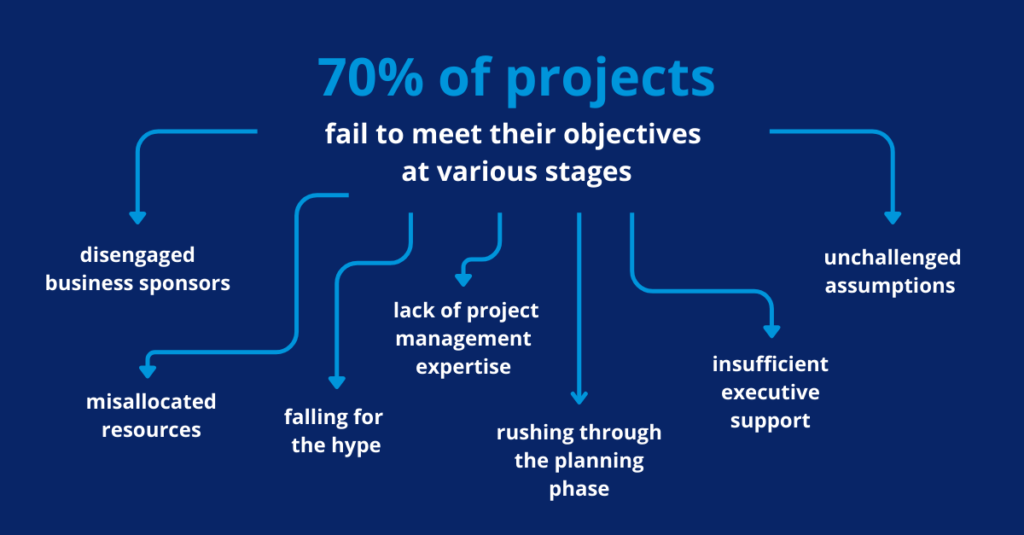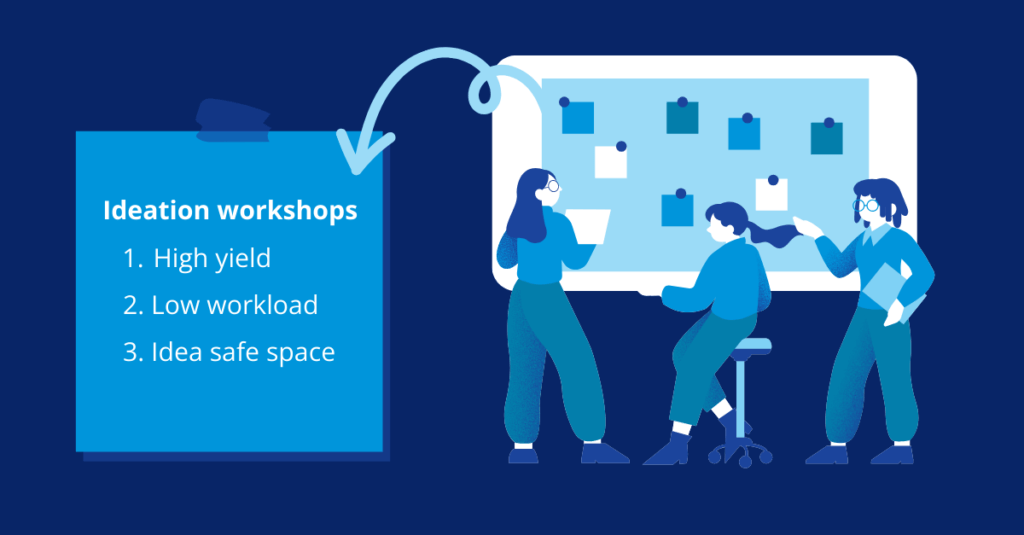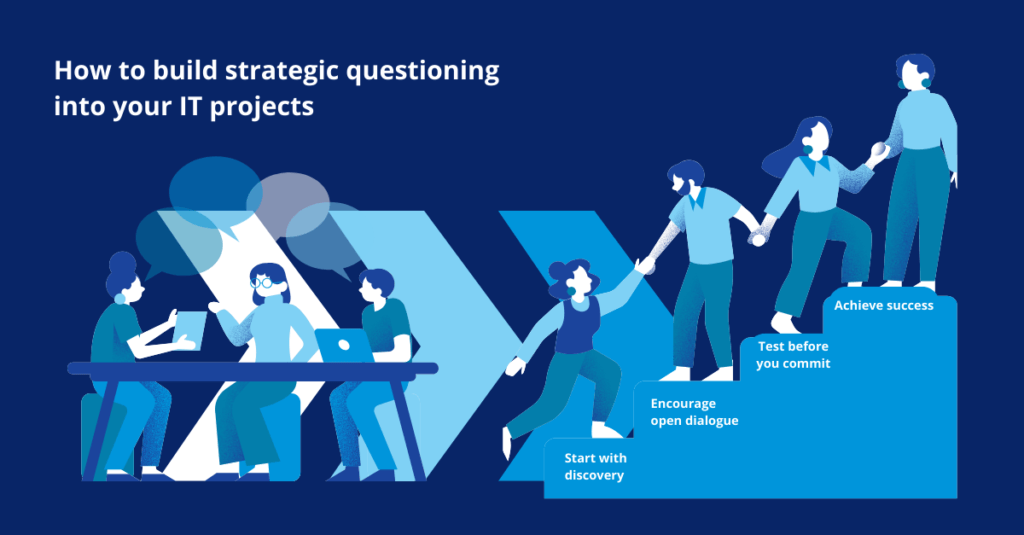- 1. Don’t Be Afraid to Doubt: Why We Challenge Our Clients’ Vision
- 2. Why Strategic Questioning Matters in Digital Transformation
- 3. The Payoff of a Questioning Mindset
- 4. The Power of Ideation Workshops
- 5. How Do Ideation Workshops Work?
- 6. Additional Benefits of Ideation Workshops
- 7. How to Build Strategic Questioning Into Your IT Projects
- 8. Conclusion
Don’t Be Afraid to Doubt: Why We Challenge Our Clients’ Vision
Picture this: your organization has just invested in a cutting-edge IT solution, designed to revolutionize how things get done. The implementation is complete, expectations are sky-high, and everyone can’t wait to see results. But then, reality sets in. Employees resist using the system. Processes feel more cumbersome instead of streamlined. Worst of all, the solution doesn’t even seem to address the issues it was supposed to solve. Sound familiar?
This scenario plays out more often than you might think. In the race to innovate and stay competitive, businesses sometimes make unchecked assumptions. When these assumptions underpin major IT projects, the cracks don’t just show — they can lead to costly missteps.
That’s why, especially in digital transformation projects, it’s not only okay to challenge assumptions—it’s essential.
Asking tough questions from the start significantly increases the likelihood that solutions will align with business goals, mitigate risks, and deliver measurable results. Because in the world of IT, the most valuable innovations aren’t always the newest or flashiest—they’re the ones that solve the right problems.
IT Projects Often Miss the Mark
IT projects often fail. The scale of the problem is difficult to quantify, as much depends on how success and failure are defined. McKinsey estimates that 70% of projects fail to meet their objectives at various stages. Experts point to factors like a lack of project management expertise, insufficient executive support, and disengaged business sponsors as primary causes. Other challenges, such as inadequate stakeholder involvement, misallocated resources, and fragmented collaboration, can further derail progress and lead to unmet goals.
But sometimes, the issue is simpler: it’s easy to fall for the hype.
With buzzwords like artificial intelligence (AI), blockchain, and the latest cloud solutions dominating the conversation, businesses often rush into new technologies without asking the critical question: Does this actually fit our needs? While pilot projects can help validate a solution, this testing should be focused on answering that fundamental question.
Another common pitfall is rushing through the planning phase. Many projects skip crucial questions, such as:
- What problem does this solution actually solve?
- Is the organization is ready for the change?
Skipping these steps might seem like an efficiency move, but it can lead to bigger obstacles down the line.
Then, there are the unchallenged assumptions—silent saboteurs. The real issue may not be what you think it is. Without questioning these assumptions, you risk flying blind, and course corrections in IT can be both expensive and disruptive.

Why Strategic Questioning Matters in Digital Transformation
In digital transformation projects, simply adopting the latest technology isn’t enough. It’s about identifying the real problem, finding the right solution, and ensuring alignment with broader business goals. Strategic questioning helps uncover the root causes behind business challenges and ensures that technology is genuinely solving the right issues.
Getting to the Root of the Problem
What often appears to be the problem is just a symptom. Strategic questioning helps uncover deeper issues that may have been overlooked. By challenging assumptions and asking the tough questions, you can avoid implementing a solution that only addresses the surface-level symptoms, leaving the core problem unsolved.
Mini Case Study: Less Really Can Be More
A client approached us with an extensive, million-dollar project , assuming they needed ten different report pages. On paper, everything seemed solid.
But when our design team asked the right questions and validated user needs, something surprising happened. Most of those reports turned out to be unnecessary. Instead of ten, we delivered just two highly focused, genuinely useful reports that supported the company’s business goals and met actual user needs.
In the end, by challenging initial assumptions and getting to the root of the problem, we not only streamlined the solution but also delivered more value with less complexity. Sometimes, less really does mean more.
Testing the Fit
Not every problem requires cutting-edge technology. Sometimes, a simpler solution works better. Strategic questioning ensures that the chosen technology is a true fit, not an overengineered solution or an underwhelming tool. It’s about finding the right balance and ensuring that the solution matches both the needs of the business and its long-term objectives.
Example: We don’t always have to apply new technologies if the group of application users is small. There are projects with only a few end users. Instead of a new technology, it is worth considering what we can add as a feature in the application—something that improves work, without creating an entirely new solution.
Exploring Alternatives Through Strategic Questioning
When you challenge assumptions, it opens the door to alternatives that may have been missed initially. This process encourages creativity and can lead to more effective solutions that better meet the organization’s goals. Rather than locking in on the first idea that comes to mind, questioning allows you to explore a range of possibilities and identify the most effective course of action.
A practical method for gaining perspective:
Try holding two separate workshops. First, meet with a representative group of end-users to understand their day-to-day challenges and what they genuinely need from a solution. Then, host a second session with managers or strategic leaders, asking them pointed questions like “Why do you believe this solution is necessary?” or “Why option A over option B?” By comparing the insights from both groups, you can see if their expectations align—or if there’s a disconnect that needs to be addressed before moving forward.
The Payoff of a Questioning Mindset
Adopting a questioning mindset in IT projects doesn’t just refine solutions—it transforms outcomes. By challenging assumptions and re-evaluating ideas, businesses achieve tighter alignment with goals. The risks? Lowered. No more spiraling budgets, missed deadlines, or flashy tools that fail to deliver. And the teams? Stronger. When every voice is heard, the result isn’t just agreement—it’s commitment.
Strategic questioning ensures solutions align with broader business objectives, not just technical needs. This alignment drives long-term success by delivering technology that genuinely moves the business forward.
By addressing potential issues early—through validation and testing—you reduce the risk of costly missteps. This approach saves time, resources, and frustration, while improving ROI by ensuring investments are targeted and effective.
Finally, involving all stakeholders fosters shared ownership. When team members feel valued, they’re more likely to champion the solution. This collaboration paves the way for smoother implementation and stronger support across the board.
The Power of Ideation Workshops
When it comes to challenging assumptions and validating solutions, one of the most effective tools at our disposal is the ideation workshop. These sessions are far more than just brainstorming exercises—they’re critical moments in the project lifecycle where we can step back, critically evaluate assumptions, and reimagine problems from fresh perspectives. Ideation workshops are structured, interactive sessions where teams come together to explore, refine, and challenge the assumptions driving a project. In these workshops, we create an environment that encourages open discussion and the exploration of alternative solutions. It’s a safe space where every idea can be put under the microscope and evaluated in terms of its true potential to solve the core problem.
Ideation workshops quickly validate ideas and objectives with minimal investment, which sets them apart from the standard, more resource-heavy approach.

How Do Ideation Workshops Work?
Ideation workshops offer more than just problem-solving — they’re a key tool in validating ideas and challenging assumptions. By involving key stakeholders early on, businesses can prevent misaligned solutions and ensure creativity is balanced with practicality.
1. Start with the big picture
We begin by revisiting the project’s main goals. What are we really trying to achieve? What assumptions are influencing the direction of the project? By addressing these fundamental questions, we ensure that everyone is aligned and focused on what truly matters—no matter how many preconceived ideas need to be challenged.
2. Dig into the details
Once the broad strokes are clear, we dive into the details. This phase involves intensive brainstorming, rapid prototyping, and testing of various solutions. We focus on uncovering potential flaws or gaps in the initial assumptions and explore alternative approaches. It’s here that the real magic happens—ideas that seemed solid on paper are tested against real-world constraints and possibilities, helping to reveal new insights.
3. Deliver actionable insights
At the end of the workshop, we don’t just walk away with a bunch of ideas. We synthesize the outcomes into clear, actionable insights that can guide the project forward. These validated recommendations provide clients with the confidence that the next steps are aligned with their objectives and will lead to a better outcome.
Additional Benefits of Ideation Workshops
- Early detection of red flags
By questioning assumptions early, ideation workshops help identify potential issues—whether technical, resource-related, or expectation mismatches—before they escalate, minimizing costly mistakes. - Fostering creativity while staying grounded
These workshops spark innovation while keeping ideas rooted in the project’s realities. It’s about finding the sweet spot between groundbreaking solutions and what is feasible within the project’s scope. - Building confidence and alignment
Involving stakeholders in the process fosters ownership and a shared sense of commitment to the solution. This collaborative approach leads to stronger buy-in and a unified path forward, ensuring that the solution is not only effective but also embraced by all.
How to Build Strategic Questioning Into Your IT Projects
Successful IT projects start with a solid foundation—and that begins with strategic questioning. While ideation workshops are an excellent method for sparking fresh thinking, it’s just as important to cultivate a mindset and organizational culture that encourages this approach throughout the project lifecycle.
The goal isn’t to create an environment where every decision is met with endless questions like “Does this make sense?” or “Why are we doing this?” The idea isn’t to paralyze progress with doubt.
Instead, it’s about structuring open thinking in a way that ensures decisions are well-founded and aligned with project objectives. This approach enables critical examination while maintaining momentum.
1. Start with discovery
Every project should begin with a discovery phase. This is where assumptions are validated, goals are clarified, and the path forward is defined. It’s not just about knowing what needs to be done—it’s about questioning why it needs to be done. What assumptions are we making, and are they based on solid data? This phase ensures that the project is grounded in a shared understanding of both challenges and desired outcomes.
2. Encourage open dialogue
A culture of open dialogue is crucial. IT consultants and business stakeholders should feel comfortable challenging each other’s ideas. The best solutions emerge from testing ideas through honest, constructive debate. By encouraging diverse perspectives, you strengthen the solution and foster a sense of shared ownership, which is essential for successful project implementation.
3. Test before you commit
Never commit to a solution without testing it first. Prototypes, pilot programs, and other experiments allow you to explore ideas in a low-risk environment before scaling up. This step helps identify potential issues early, ensuring that the chosen solution aligns with business needs and is viable in the long run.

Conclusion
Speed is crucial in IT project delivery. Organizations face constant pressure to move faster, adopt innovations, and stay ahead of the curve. Data-driven solutions, automation, and AI aren’t just tools for streamlining processes—they’re often the foundation of a company’s competitive edge.
In such a fast-paced environment, it’s no surprise that tight deadlines and time pressures have become natural elements of every project. But these same factors can lead to losing sight of the original purpose of an implementation—its strategic significance and added value. That’s why it’s critical to set the right direction from the start.
How can your organization balance speed with strategic focus in its IT projects? Begin by asking three critical questions:
- Are our actions aligned with long-term vision and business goals?
- Have we engaged all relevant decision-makers for project success?
- Does the solution truly address the identified business and user needs?
Embracing doubts and asking tough questions isn’t about slowing things down—it’s about ensuring that your organization is investing in solutions that genuinely address its needs, rather than chasing the latest trends.
Would you like more information about this topic?
Complete the form below.
